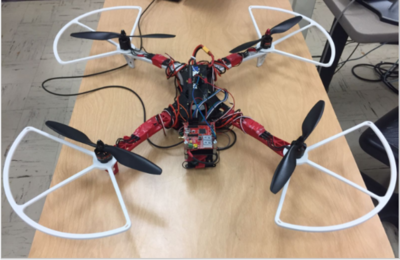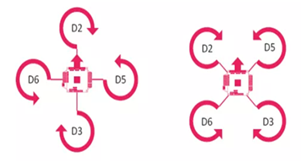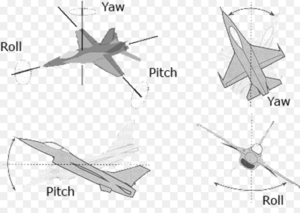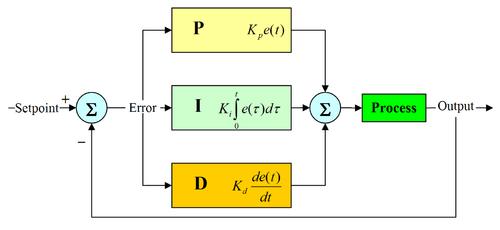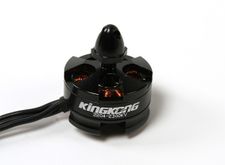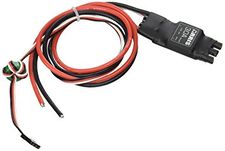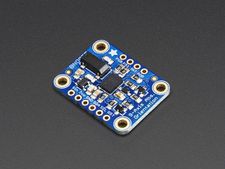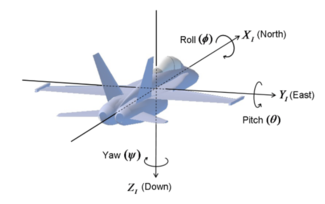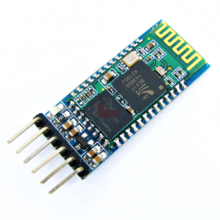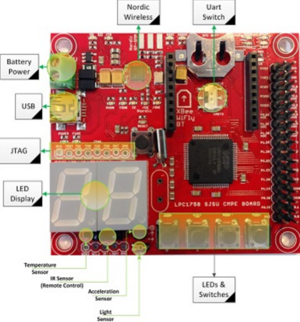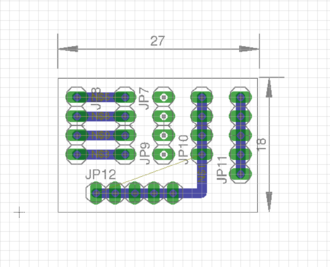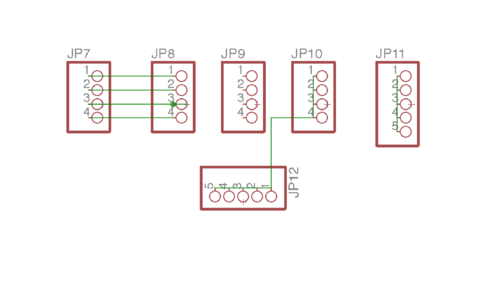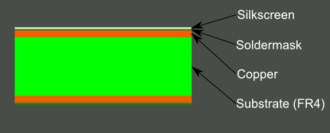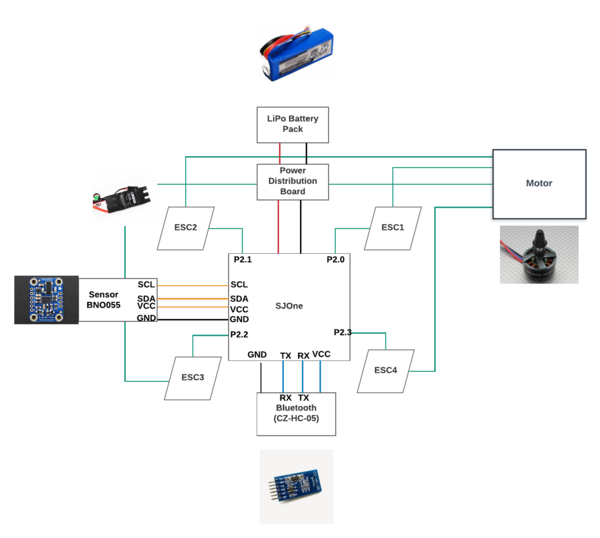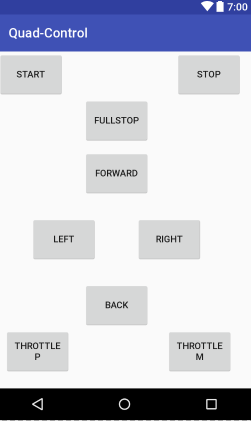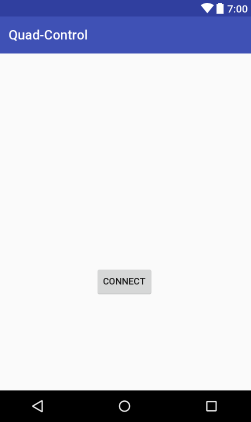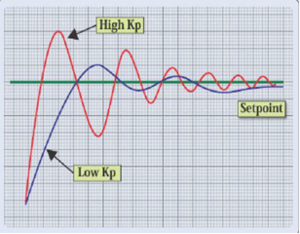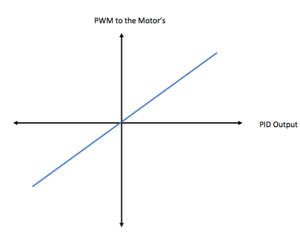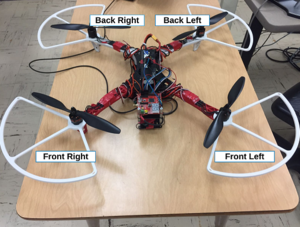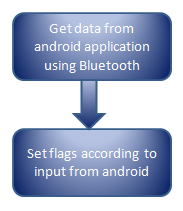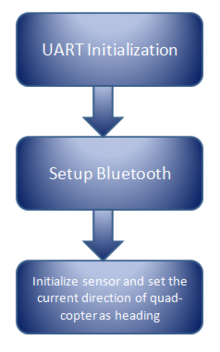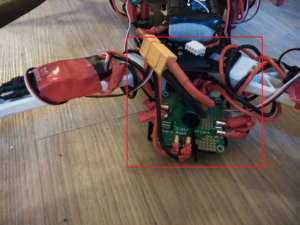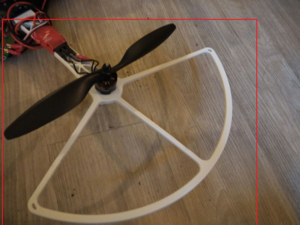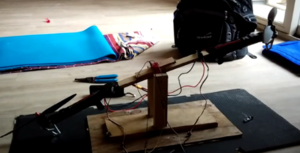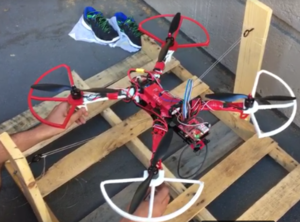Difference between revisions of "S17: Sky Knight"
Proj user6 (talk | contribs) (→PCB Design) |
Proj user12 (talk | contribs) (→Motors) |
||
| (131 intermediate revisions by 4 users not shown) | |||
| Line 1: | Line 1: | ||
| − | |||
| − | |||
| − | |||
| − | |||
| − | |||
| − | |||
| − | |||
| − | |||
| − | |||
| − | |||
| − | |||
== Sky Knight == | == Sky Knight == | ||
| − | [[File: | + | [[File:CmpE244_S17_Sky_Knight_Quad-copter.PNG|400px|center|thumb|Quad-copter]] |
== Abstract == | == Abstract == | ||
| Line 27: | Line 16: | ||
=== Basics === | === Basics === | ||
| − | [[File:CmpE244_S17_Sky_Knight_XConfigQuad-copter.PNG|400px|left|thumb| | + | [[File:CmpE244_S17_Sky_Knight_XConfigQuad-copter.PNG|400px|left|thumb| Quad-copter “+” and “X” configuration ]] |
| Line 42: | Line 31: | ||
| − | [[File:CmpE244_S17_Sky_Knight_Pitch.PNG|300px|left|thumb| | + | [[File:CmpE244_S17_Sky_Knight_Pitch.PNG|300px|left|thumb| Pitch,roll,yaw angles ]] |
| + | |||
| + | |||
| Line 68: | Line 59: | ||
| + | A PID system is a type of control system, where we regulate the input signal using feedback signal. PID algorithm is very important for quad-copter as it requires high level of stability to hover in the air. | ||
| + | PID stands for Proportional, Integral and Derivative. The P term simply generates a response to motors which is directly proportional to the error angle. | ||
| + | The D term is used to reduce the errors our system is going to make in the future. It is calculated as error/(time between consecutive reading). So if the P term is giving some more response than required, D term will minimize it to a value lower than set point. Integral term collects the errors in the past and covers up for those errors, so that the correction will bring the system exactly to the set point. | ||
| + | |||
| + | The PID equation is written as: | ||
| + | |||
| + | PID Output = Kp * P + Kd *D + Ki * I; | ||
| + | |||
| + | where, | ||
| + | |||
| + | Kp = Proportional constant | ||
| + | |||
| + | Kd = Derivative constant | ||
| + | |||
| + | Ki = Integral constant | ||
| + | |||
| + | |||
| + | [[File:CMPE244_S17_SkyKnight_PIDController.png|500px|center|thumb| PID feedback loop ]] | ||
=== Team Members & Responsibilities === | === Team Members & Responsibilities === | ||
* [https://www.linkedin.com/in/nikhil-namjoshi-47636191/ Nikhil Namjoshi]<br> | * [https://www.linkedin.com/in/nikhil-namjoshi-47636191/ Nikhil Namjoshi]<br> | ||
| + | * [https://www.linkedin.com/in/samiksha-ambekar Samiksha Ambekar]<br> | ||
* [https://www.linkedin.com/in/rimjhimghosh/ Rimjhim Ghosh]<br> | * [https://www.linkedin.com/in/rimjhimghosh/ Rimjhim Ghosh]<br> | ||
* [https://www.linkedin.com/in/rajeev-sawant-096561bb/ Rajeev Sawant]<br> | * [https://www.linkedin.com/in/rajeev-sawant-096561bb/ Rajeev Sawant]<br> | ||
| − | |||
== Schedule == | == Schedule == | ||
| Line 153: | Line 162: | ||
* More testing and Tuning | * More testing and Tuning | ||
* Project Presentation | * Project Presentation | ||
| − | | | + | | Completed |
| − | | | + | | 5/25/2017 |
|- | |- | ||
! scope="row"| 9 | ! scope="row"| 9 | ||
| Line 161: | Line 170: | ||
| | | | ||
* Final Demo and complete project report | * Final Demo and complete project report | ||
| − | | | + | | Completed |
| − | | | + | | 5/25/2017 |
|- | |- | ||
|} | |} | ||
| Line 218: | Line 227: | ||
A 4 axis UFO with propeller guard is being used for this project. The frame and the guards were mainly used considering our requirement and safety reasons. We have also used a BNO055 9 DOF Adafruit sensor, which is been interfaced with the SJOne. An I2C data communication takes place between the Sensor and the LPC Board , to send the data from the sensor to the board whose values are been used to stabilize the flight of the Quadcopter. | A 4 axis UFO with propeller guard is being used for this project. The frame and the guards were mainly used considering our requirement and safety reasons. We have also used a BNO055 9 DOF Adafruit sensor, which is been interfaced with the SJOne. An I2C data communication takes place between the Sensor and the LPC Board , to send the data from the sensor to the board whose values are been used to stabilize the flight of the Quadcopter. | ||
| − | [[File: | + | [[File:CmpE244_S17_Sky_Knight_Hardware_block_diagram.png|center|500px|thumb|Hardware Block Diagram]] |
=== Motors === | === Motors === | ||
| − | [[File: | + | [[File:CmpE244_S17_Sky_Knight_motor.jpg|225px|left|thumb| Brushless Motors]] |
| + | |||
| + | |||
We have implemented Brushless motors for our quadcopter. They are much more powerful and energy efficient, unlike DC motors. The kV rating on the motor indicates how many RPM the motor can rotate for the given number of volts. Brushless motors work by producing magnetic fields to produce electric charges. The speed of the spinning motor is controlled by an ESC. In our Quadcopter we have 2 motors on the diagonals moving in clockwise while the other two in anti-clockwise. | We have implemented Brushless motors for our quadcopter. They are much more powerful and energy efficient, unlike DC motors. The kV rating on the motor indicates how many RPM the motor can rotate for the given number of volts. Brushless motors work by producing magnetic fields to produce electric charges. The speed of the spinning motor is controlled by an ESC. In our Quadcopter we have 2 motors on the diagonals moving in clockwise while the other two in anti-clockwise. | ||
| + | |||
| + | === Electronic Speed Controller (ESC) === | ||
| + | |||
| + | [[File:CmpE244_S17_Sky_Knight_ESC.jpg|225px|left|thumb| Electronic Speed Control]] | ||
| + | |||
| + | |||
| + | We have used ESC (Electronic Speed Control) to control the motor rotation speed also to set its direction (clockwise or anti-clockwise ).The ESC will control the PWM values provided to it by LPC 1758 board. Our ESC runs at about 400 Hz with pulse widths that range from 3.12ms to 6.25 ms. 3.12 ms turns off the motor input while 6.25 ms makes the motor run at max speed. The OPTO brushless ESC is programmable, and has several different parameters for the user to configure. | ||
| Line 236: | Line 254: | ||
| + | === Sensor === | ||
| + | [[File:CmpE244_S17_Sky_Knight_Sensor.jpg|225px||thumb|left| Adafruit 9 DOF Sensor]] | ||
| + | [[File:CmpE244_S17_Sky_Knight_Eulers_angles.PNG|325px||thumb|right| Euler's Angle]] | ||
| + | We are using BNO055 sensor to measure the orientation of our quad-copter.This sensor is 9-axis absolute orientation sensor. It has an advanced tri-axial 16 bit gyroscope, a versatile, leading edge tri-axial 14 bit accelerometer and a full performance geomagnetic sensor. We get fused sensor data output of Quaternion, Euler angles, Rotation vector,Linear acceleration, Gravity, Heading. We have interfaced BNO055 sensor with SJOne board using I2C. We are getting Pitch, Roll and Yaw angle with 16 bit precision and giving these values as input to our PID controller to maintain the stable orientation. | ||
| − | |||
| − | |||
| − | |||
| Line 251: | Line 270: | ||
| + | === Bluetooth === | ||
| + | [[File: CMPE244_S17_SkyKnight_BluetoothHC-05.png|220px|left|thumb| SJOne Board]] | ||
| − | |||
| − | |||
| − | |||
| − | |||
| + | We are using bluetooth HC-05 module as medium of communication between SJONE board and android phone. There is one way communication from Android phone to SJONE i.e. to send the commands. The Bluetooth module is interfaced to SJONE using UART communication. The bluetooth module can be configured to support baud rates of 9600,19200,38400,57600,115200,230400,460800 but we are using the default baud rate o 38400. | ||
| Line 279: | Line 297: | ||
=== SJOne Flight Controller === | === SJOne Flight Controller === | ||
| − | [[File: | + | [[File:CmpE244_S17_Sky_Knight_CaptureSjone.PNG|300px|left|thumb| SJOne Board]] |
| − | + | ||
| + | |||
| + | SJOne was used as a controller for the flight of the Quadcopter. We have interfaced Bluetooth, Sensor and PCB (used for interfacing with the motor). Each of this modules are controlled by the board. We have controlled the Flight of the Quadcopter using Android app. The board will be provided with the information through app and will compute the PWM values and provide it to the ESC. The Board will process the data provided from the sensor and will compute the values of P , I and D for Yaw , Pitch and Roll. SJOne Board controls every aspect required for the quadcopter to fly. Every activity should go through the SJOne i.e it is used as a medium of communication. FreeRTOS is used on the board. We have used FreeRTOS task for periodically calling various functions. | ||
| + | |||
| + | |||
| + | |||
| + | |||
| + | |||
| + | |||
| + | |||
| + | |||
| + | |||
| + | |||
| + | |||
| + | |||
| + | |||
| + | |||
| + | |||
| + | |||
| + | |||
| + | |||
| Line 287: | Line 325: | ||
| + | === PCB Design === | ||
| + | [[File:CmpE244_S17_Sky_Knight_PCB_Schematic.png|left|330px|thumb|PCB Board]] | ||
| + | [[File:CmpE244_S17_Sky_Knight_PCB_Board.png|center|490px|thumb|PCB Schematic]] | ||
| + | |||
| + | A Printed Circuit Board or PCB is a plate or board used for placing the different elements that conform an electrical circuit that contains the electrical interconnections between them.The most simple printed circuit boards are the ones that contain copper tracks or interconnects only on one of its surfaces. These kinds of boards are known as 1 layer printed circuit board or 1 layer PCB.The most common PCB's manufactured today are the ones that contain 2 layers, that is, you can find interconnects in both surfaces of the board. However, depending on the physical complexity of the design ( PCB layout ), the boards can be manufactured with 8 or more layers. Ours is 1 layer PCB. Our PCB design consisted of Silkscreen and Soldermask on the top side and copper layer on the bottom side. | ||
| + | We made a PCB to connect the PWM signal pins of the SJONE board to ESC's signals pins and also provide VCC and GND to the peripherals.Designing PCB in Eagle is a 2 step process. First, design a schematic and then use the designed schematic for board representation.Eagle's board and Schematic work hand-in-hand. | ||
| + | '''Circuit Schematic or Schematic''' | ||
| + | The Schematic is the representation of the electronic system using abstract, graphic symbols. Drawing a Schematic is always the first step of designing a PCB. Usually, PCB design software contains separate tools for Schematic and PCB design. Often a PCB is represented by multiple Schematic pages separated by functions, like power domain, analog signal domain, inputs/outputs.You can use the libraries provided by Adafruit or Eagle to get the components to your schematic. | ||
| + | '''Layer Overview''' | ||
| + | PCB composition is all about layering one material over another. The thickest, the middle part of the board is an insulating substrate (usually FR4). On either side of that is a thin layer of copper, where our electric signals pass through. To insulate and protect the copper layers, we cover them with a thin layer of lacquer-like solder mask, which is what gives the PCB color (green, red, blue, etc.). Finally, to top it all off, we add a layer of ink-like silkscreen, which can add text and logos to the PCB. | ||
| + | [[File:CmpE244_S17_Sky_Knight_PCB_Layer.png|center|330px|thumb|PCB Layer]] | ||
| + | '''Checking for Error''' | ||
| + | * The first check is to make sure you’ve actually routed all of the nets in your schematic. To do this, hit the RATSNEST icon. | ||
| + | * Once you’re done routing there’s just one more check to be made: the design rule check (DRC).To do this you need to download DRC Library. You should expect “DRC: No errors.” | ||
| + | |||
| + | '''Generating Gerbers''' | ||
| + | Gerber files – note the plurality – each describes single layers of the PCB. One Gerber might describe the silkscreen, while another defines where the top copper is. In all, we’ll generate seven Gerber files to send to the fab house. | ||
| + | * CAM Processor - we "Process Job" to create the Gerber files. | ||
| + | * Picking a PCB Manufacturer - We picked PCBWay for the manufacturing of our PCB. | ||
| + | * Delivering the Gerbers - We generated GTL, GBL, GTS, GBS, GTO, GBO and the TXT files and send them this. | ||
| + | |||
| + | === Hardware Interface === | ||
| + | [[File:CmpE244_S17_SkyKnight_HardwareInt.png|center|600px|thumb|Hardware Design]] | ||
| + | The protocols used for the interfacing are: | ||
| + | * '''I2C''' : For the communication between the SJOne and Sensor (BNO055). Since I2C is fast communication protocol and values from sensor decides the entire flight so this protocol was used. | ||
| + | * '''UART''' : Bluetooth and SJOne communication was made using this protocol. | ||
| + | * '''GPIO''' : All the ESCs' were connected using GPIO pins as can be viewed in the diagram above. | ||
| + | === Software Design === | ||
| + | Software design part involves writing code for interfacing SJONE with bluetooth, ESCs, sensor,android application code and PID algorithm. We have written UART communication code to communicate with Bluetooth and I2C communication code for communication with orientation sensor. We have created a 10Hz task that constantly checks if the user has sent any commands from the android apps. Software design majorly involves the PID algorithm code which is the most essential element of the software design. We have written the code in 100 Hz task since quad-copter requires hard real time processing. In this processing the algorithm takes input from the sensor, calculates the required PWM for each motor and provides PWM pulses to them accordingly. | ||
| + | ==== Android Application ==== | ||
| + | Android Application is used to control the quad-copter. We have created the the simple user interface which allows user to start and stop the quad-copter.<br> We have configured two activities in our application. In first activity that is in first page we have one button that connects to the Bluetooth and once Bluetooth connection is established , application is navigated to second page.<br> | ||
| + | In first page, we have provided button named "CONNECT" which allows user to start the Bluetooth connection<br> | ||
| + | In the second page, we have provided the buttons to control our quad-copter. <br> | ||
| − | |||
| + | [[File:CmpE244_S17_Sky_Knight_AndroidSecond1.PNG|right|300px|thumb|Android Application Second Page]] | ||
| + | [[File:CmpE244_S17_Sky_Knight_AndroidIcon.PNG|left|300px|thumb| Android Application Icon]] | ||
| + | [[File:CmpE244_S17_Sky_Knight_AndroidFirstPage.PNG|center|300px|thumb| Android Application First Page]] | ||
| − | + | ||
| − | |||
| − | + | ||
| + | Total 9 buttons are provided to user. The names and the functionality of each button is as follows: | ||
| − | 1) | + | 1) START : This button starts the quad-copter. |
| − | 2) STOP : This button helps user to stop the quad-copter slowly. | + | 2) STOP : This button helps user to stop the quad-copter slowly. |
3) FULLSTOP : This button stops the SJOne board. Thus, immediately stops the quad-copter. | 3) FULLSTOP : This button stops the SJOne board. Thus, immediately stops the quad-copter. | ||
| − | 4) | + | 4) FORWARD : This button moves the quad-copter in the Front direction. |
| − | 5) | + | 5) LEFT : This button moves the quad-copter in the Left direction. |
| − | 6) | + | 6) BACK : This button moves the quad-copter in the Back direction. |
| + | |||
| + | 7) RIGHT : This button moves the quad-copter in the Right direction. | ||
| + | |||
| + | 8) Throttle P : To increase the throttle. This increases the PWM value by 0.02 when pressed. | ||
| + | |||
| + | 9) Throttle M : To decrease the throttle. This decreases the PWM value by 0.02 when pressed. | ||
| + | |||
| + | |||
| + | *Buttons such as FORWARD, LEFT , RIGHT and BACK are implemented using android functionality named Ontouch. | ||
| + | **This functionality detects the click of button as well as release of the button.<br> | ||
| + | **Once the button is pressed, we are setting the particular set-point value and quad-copter maintains that particular set-point and moves in required direction.<br> | ||
| + | **Once we detect the release of button, we change the set-point to zero and stabilize the quad-copter so that it stops the motion of going backward,forward, right or left.<br> | ||
| + | |||
| + | |||
| + | *All the other buttons are implemented using android functionality named OnClick. This functionality only detects the release of the button and follows the instruction accordingly. | ||
| + | |||
| + | ==== PID Controller ==== | ||
| + | [[File:CmpE244_S17_SkyKnight_CapturePIDWaveform.PNG|300px|right|thumb|PID Graph]] | ||
| + | The important part of the project was to make the Quad-copter stable, for which we have used PID algorithm. PID stands for Proportional, Integral and Derivative algorithm. PID is a closed loop system which computes the values of the error based on the values obtained from the Sensor. We had an initial Set-point value in our code, which as obvious would be the ideal error values that we expect from our Quad-copter. For computation of the P, we used the difference between the Set Point and the angle that you got from the sensor, this provides us the error. Then for computing , we take the difference of current error and previous error and divide that value with the time interval between them. For our case the time interval was 0.01s, since we are obtaining the values from the sensor in 100HZ task. Now even after using the values of P and D to minimize the error, we have to use I since it doesn't totally make the value of the error entirely zero. So in case of I we calculate the sum of last 6 error i.e. cumulative sum of previous 6 error. I keeps track of the small errors we failed to correct in the past and provides little bit extra correction to support P. | ||
| + | Note : We always take the absolute value of I as error can be positive and negative and it can cancel the summation effect. | ||
| + | |||
| + | '''Observation:''' | ||
| + | |||
| + | When P is too high , the Quad-copter will correct itself beyond the Set-Point, but if P is too less, it will give slow response and may not become stable. | ||
| + | |||
| + | Usually the value of D should be less compared to P. But if the value of D is greater than P, then it provides an incorrect response i.e. consider the scenario when you want to turn RIGHT, but if the value of D is greater than P, it will take a LEFT. If D is too less, then it wont correct the overshoot error made by P and then the system will overshoot. | ||
| + | |||
| + | The value of I is supposed to be less than P, but if I is greater than P then it will have a overshoot and if the value of I is too less than P, then we observe some vibrational motions of the Quad-copter. So the value of I should be less than P, but high enough to avoid vibrations. | ||
| + | |||
| + | [[File:CMPE244_S17_SkyKnight_Graph.png|300px|left|thumb| PID Mapping Waveform]] | ||
| + | |||
| + | |||
| + | |||
| + | |||
| + | We need to calculate the slope of the frequency vs PWM graph. We can calculate it using minimum and maximum values of frequency and PWM which we will be using in the algorithm. This value can differ for different systems. We can use below the formula: | ||
| + | |||
| + | PWM variant = Slope * PID output; | ||
| + | |||
| + | We need to add/subtract this PWM variant in the current PWM value to stabilize the Quadcopter. First, we will get the output from all three PID controllers and then we will set the PWM value. We can make the function to set the PWM and call it after execution of all three PID controllers. | ||
| + | |||
| + | |||
| + | |||
| + | |||
| + | |||
| + | |||
| + | |||
| + | |||
| + | |||
| + | |||
| + | |||
| + | |||
| − | + | ==== Implementation ==== | |
| − | + | [[File:CMPE244_S17_SkyKnight_Blank_ERD_&_Data_Flow_-_Page_1.png|300px|right|thumb| Quad-copter with motor configuration ]] | |
| − | |||
| + | Android application communicates with SJOne board using Bluetooth HC-05 module. SJOne board is interfaced with Bluetooth HC-05 using UART. We have used four ESCs (Electronic Speed Controller) to drive four motors of Quad-copter. We are giving PWM signals from LPC1758 to these four ESCs. | ||
| + | We have used BNO055 which has 9 Degree of Freedom. This sensor breakout has accelerometer, gyroscope, magnetometer sensor. We are getting pitch, roll and yaw angle values from fusion of these sensors with 16 bit precision. BNO055 Sensor is interfaced with LPC1758 using I2C communication.<br> | ||
| + | We are manipulating the sensor values before sending it to PID controller to get positive and negative errors as follows: <br> | ||
| + | When quad-copter moves in the Backward direction , we have considered pitch angle to be negative.<br> | ||
| + | When quad-copter moves in the Forward direction , we have considered pitch angle to be positive.<br> | ||
| + | When quad-copter rolls in the Left direction , we have considered roll angle to be negative.<br> | ||
| + | When quad-copter rolls in the Right direction , we have considered roll angle to be positive.<br> | ||
| + | When quad-copter moves to the Left direction with respect to yaw axis , we have considered yaw angle to be negative.<br> | ||
| + | When quad-copter moves to the Right direction with respect to yaw axis , we have considered yaw angle to be positive.<br> | ||
| + | [[File:CmpE244 S17 SkyKnight SKGIF.gif|500px|center|thumb| Orientation GIF ]] | ||
| Line 344: | Line 477: | ||
| + | The crucial part of this project is to make quad-copter stable. PID algorithm plays an important part in stabilizing the quad-copter. After designing the PID algorithm, we have tuned the PID algorithm to get correct values of all its constants. We have tuned three constants “Kp” for Proportional term, “Ki” for integral term and “Kd” for derivative term. We have implemented three PID algorithms each for pitch, roll and yaw axis. Below is the output which we get from our PID controller. | ||
| − | === | + | PID Output = Kp * P + Kd *D + Ki * I;<br> |
| − | + | ||
| − | + | where,<br> | |
| + | P(error) = set point – current angle (pitch, roll or yaw )<br> | ||
| + | I = (sum of absolute value of past errors) * sampling time<br> | ||
| + | D = error / Sampling time<br> | ||
| + | |||
| + | |||
| + | We need to add/subtract this PWM variant in the current PWM value to stabilize the quad-copter. First, we will get the output from all three PID controllers and then we will set the PWM value. We can make the function to set the PWM and call it after execution of all three PID controllers.<br> | ||
| + | |||
| + | |||
| + | |||
| + | *For Pitch PID controller below are the changes done in PWM :<br> | ||
| + | |||
| + | FR PWM = Present Motor FR PWM - PWM variant<br> | ||
| + | FL PWM = Present Motor FL PWM - PWM variant<br> | ||
| + | BR PWM = Present Motor BR PWM + PWM variant<br> | ||
| + | BL PWM = Present Motor BL PWM + PWM variant<br> | ||
| + | |||
| + | *For Roll PID controller below are the changes done in PWM :<br> | ||
| + | |||
| + | FR PWM = Present Motor FR PWM - PWM variant <br> | ||
| + | FL PWM = Present Motor FL PWM + PWM variant <br> | ||
| + | BR PWM = Present Motor BR PWM - PWM variant <br> | ||
| + | BL PWM = Present Motor BL PWM + PWM variant <br> | ||
| + | |||
| + | *For Yaw PID controller below are the changes done in PWM :<br> | ||
| + | |||
| + | FR PWM = Present Motor FR PWM - PWM variant <br> | ||
| + | FL PWM = Present Motor FL PWM + PWM variant <br> | ||
| + | BR PWM = Present Motor BR PWM + PWM variant <br> | ||
| + | BL PWM = Present Motor BL PWM - PWM variant <br> | ||
| − | + | Where,<br> | |
| − | + | FR stands for Front Right motor <br> | |
| + | FL stands for Front Left motor <br> | ||
| + | BR stands for Back Right motor <br> | ||
| + | BL stands for Back Left motor <br> | ||
| − | + | *For Pitch calculations, we have subtracted the PWM variant from front motors and added this variant to back motors. This helps to keep quad-copter stable on pitch axis. <br> | |
| − | |||
| − | + | *For Roll calculations, we have subtracted the PWM variant from right motors and added this variant to left motors. This stabilizes the quad-copter on Roll axis.<br> | |
| − | |||
| − | + | *For Yaw calculations, we have added and subtracted the PWM variant to the diagonal motors. We subtract the PWM variant from front right and back left and add this variant to front left and back right motors. This will ensure that quad-copter remains stable on the yaw axis.<br> | |
| − | + | *Total thrust generated by all four motors needs to be constant to stabilize the quad-copter. Thrust is proportional to PWM of motors so in the above algorithm, the sum all PWM of all motor must remain same. This helps to fly the quad-copter at particular height with stability. | |
| − | * | ||
| − | |||
| − | |||
| − | |||
| − | |||
| − | |||
| − | |||
| − | + | [[File:CmpE244_S17_Sky_Knight_Capture_10Hz.PNG|220px|left|thumb| 10Hz task flow ]] | |
| − | |||
| − | + | [[File:CmpE244_S17_Sky_Knight_CaptureInit.PNG |220px|right|thumb| Init function task flow ]] | |
| − | + | [[File:CmpE244_S17_Sky_Knight_Capture100Hz.PNG|400px|center|thumb| 100Hz task flow ]] | |
| − | |||
| − | + | In our software implementation, we have first initialized all the communication with sensor and Bluetooth. | |
| − | + | We are taking android application commands in 10 HZ task using Bluetooth. According to the commands received from android , we are assigning values to our variables. We are setting these values in 100Hz task. The commands from android application can be start,stop,forward,backward. According to the values of our variables, we giving input to our PID controllers. We have implemented PID controller in 100 Hz task. First, we get pitch value from the sensor then we set the base PWM value. After setting the base PWM value , PID controller is implemented for pitch,roll and yaw axis. We limit PWM value at this stage. In this PWM limit unction we have made sure that our PWM value stays in range of minimum and maximum. | |
== Testing & Technical Challenges == | == Testing & Technical Challenges == | ||
| + | |||
1) Weight Distribution - First challenge to us was to distribute the weight of the things on quad-copter in even manner. Weight distribution is important to ensure flight stability. Of course we have PID algorithm to ensure stable flight, but it is our responsibility to distribute weight in proper manner and minimize the work of PID in any way possible. Things like motors, propellers are already in correct place in terms of weight distribution since the chassis was designed accordingly. Things that we needed to place correctly and that had significant weight were battery, SJONE board, Power bank, ESCs, power distribution board. We placed the ESCs on each arm of the quad-copter i.e. near the motors. In the middle part of the chassis we placed SJONE on one end and on other end we placed Power Distribution board. We placed the battery exactly at the middle part of the upper layer and the power bank is also placed at middle part of the lower layer. | 1) Weight Distribution - First challenge to us was to distribute the weight of the things on quad-copter in even manner. Weight distribution is important to ensure flight stability. Of course we have PID algorithm to ensure stable flight, but it is our responsibility to distribute weight in proper manner and minimize the work of PID in any way possible. Things like motors, propellers are already in correct place in terms of weight distribution since the chassis was designed accordingly. Things that we needed to place correctly and that had significant weight were battery, SJONE board, Power bank, ESCs, power distribution board. We placed the ESCs on each arm of the quad-copter i.e. near the motors. In the middle part of the chassis we placed SJONE on one end and on other end we placed Power Distribution board. We placed the battery exactly at the middle part of the upper layer and the power bank is also placed at middle part of the lower layer. | ||
| Line 395: | Line 551: | ||
3) Motor Issues - During testing we damaged two to three motors as they got over heated and hence we had to replace them. | 3) Motor Issues - During testing we damaged two to three motors as they got over heated and hence we had to replace them. | ||
| + | |||
| + | [[File:CMPE244_S17_SkyKnight_PowerDistributionBoard.PNG|300px|left|thumb| Power Distribution Board ]] | ||
4) Power Distribution - At the beginning we had build our own power distribution board to distribute power using solder iron and solder material. It took input power from the battery and distributed to the four different port which are connected to the ESCs. But during testing our power distribution board was burnt twice and probably that was the reason for our motor getting over heated. So we ordered a good power distribution board online. | 4) Power Distribution - At the beginning we had build our own power distribution board to distribute power using solder iron and solder material. It took input power from the battery and distributed to the four different port which are connected to the ESCs. But during testing our power distribution board was burnt twice and probably that was the reason for our motor getting over heated. So we ordered a good power distribution board online. | ||
| + | |||
| + | |||
| + | |||
| + | |||
| + | |||
| + | |||
| + | |||
| + | |||
| + | |||
| + | |||
| + | |||
| + | |||
| + | |||
| + | |||
| Line 405: | Line 577: | ||
| − | 6) Propellers - When we started testing we broke several of our propellers are they were not guarded. Later we bought guards to protect the propellers. | + | [[File:CMPE244_S17_SkyKnight_GuardImage.png|300px|left|thumb| Guard to protect Propellers ]] |
| + | |||
| + | |||
| + | 6) Propellers - When we started testing we broke several of our propellers are they were not guarded. Later we bought guards to protect the propellers and also some extra propellers as a backup. | ||
| + | |||
| + | |||
| + | |||
| + | |||
| + | |||
| + | |||
| + | |||
| + | |||
| + | |||
| + | |||
| + | |||
| + | |||
| + | |||
| + | |||
| + | |||
| + | |||
| Line 411: | Line 602: | ||
7) Orientation Sensor - We were using CMPS11 sensor that gave us orientation in terms of roll and pitch angles. We were not considering yaw angle at that point. But after reading a lot about quad-copter discussions we found that the 8 bit precision of that sensor was not enough for stable flight. So we replaced the sensor with BNO055 that gave us 16 bit precision of roll, pitch and yaw values which was more that enough for the stable flight. | 7) Orientation Sensor - We were using CMPS11 sensor that gave us orientation in terms of roll and pitch angles. We were not considering yaw angle at that point. But after reading a lot about quad-copter discussions we found that the 8 bit precision of that sensor was not enough for stable flight. So we replaced the sensor with BNO055 that gave us 16 bit precision of roll, pitch and yaw values which was more that enough for the stable flight. | ||
| + | |||
| + | [[File:CMPE244 S17 SkyKnight SensorPlacement.png|300px|left|thumb| Sensor Placement ]] | ||
| Line 416: | Line 609: | ||
| − | [[File:CmpE244 S17 Sky Knight SeeSawTesting.PNG|300px|left|thumb| | + | [[File:CmpE244 S17 Sky Knight SeeSawTesting.PNG|300px|left|thumb| PID tuning on SeeSaw structure ]] |
| − | |||
| − | |||
| Line 429: | Line 620: | ||
| − | |||
| Line 435: | Line 625: | ||
| + | 9) PID - The biggest challenge of all we faced was the PID algorithm. This challenge was so big that it took us a lot of time to understand it well and then implement it. We were doing it all wrong at the beginning. We were trying to fly our quad-copter which was incorrect and of course the quad behaved weird with that algorithm. Also we were running the algorithm with 10Hz task but we understood later that 10hz is very slow to process the algorithm and hence we switched to 100hz task. We knew we had to have a testing setup to get the PID algorithm correct. So we built the seesaw setup such that each end of the wooden plate has motor mounted to it. Then we wrote the PID algorithm for two motors such that the seesaw would balance itself. We perfected our PID algorithm with this setup. You can see the video 'PID Testing using Seesaw stand' below in videos section. | ||
| + | [[File:CmpE244 S17 Sky Knight QuadcopterTesting.PNG|300px|left|thumb|Testing quad-copter on wooden structure ]] | ||
| Line 448: | Line 640: | ||
| + | 10) Testing challenge in real field - After we got our PID algorithm correct, we decided to built a wooden structure to mount our quad-copter and test it as shown in the image. We mounted our quad-copter using nylon wires to the hook at the side and tested whether the PID algorithm is able to keep it stable or not. | ||
| Line 464: | Line 657: | ||
| + | == Conclusion == | ||
| + | This project was a big challenge to us and was difficult to implement it in small time. But it was a great learning lesson overall to everyone of us. We learned many important things like basics requirement for quad-copter and its configuration, understanding of PID algorithm, hard real time software implementation and structural aspects of a quad-copter. The most important thing that we learned is to solve real world problems with correct approach. We successfully overcame the challenges and were able to achieve smooth flight of quad-copter. | ||
| − | === | + | === Project Video === |
| − | |||
| − | + | * Final Flight | |
| − | + | https://youtu.be/Gpav7ml6Ntg | |
| + | |||
| + | *Semi Final : | ||
| + | https://youtu.be/scjI6HGl9Ao | ||
| − | + | *On Field Testing Initial Phase | |
| − | On Field Testing Initial Phase | ||
https://youtu.be/lQm-Qdt1894 | https://youtu.be/lQm-Qdt1894 | ||
| − | Quad-copter Rope Tied Testing | + | *Quad-copter Rope Tied Testing |
https://youtu.be/-ZVfokUFFPo | https://youtu.be/-ZVfokUFFPo | ||
| − | PID Testing using Seesaw stand: | + | *PID Testing using Seesaw stand: |
https://youtu.be/ftO13CeKirc | https://youtu.be/ftO13CeKirc | ||
| − | Quad-copter Stand Mount Testing | + | *Quad-copter Stand Mount Testing |
https://youtu.be/Me5hdb_TkGU | https://youtu.be/Me5hdb_TkGU | ||
| − | Quad-copter Hover Video | + | *Quad-copter Hover Video |
https://youtu.be/R3oFnWLibLk | https://youtu.be/R3oFnWLibLk | ||
| − | + | *Quad-copter Back Motion Control Video | |
| − | |||
| − | |||
| − | Quad-copter Back Motion Control Video | ||
https://youtu.be/y9nNN9IHd-w | https://youtu.be/y9nNN9IHd-w | ||
| − | Quad-copter Backward and Right Motion Video | + | *Quad-copter Backward and Right Motion Video |
https://youtu.be/z-7jj8FxK8c | https://youtu.be/z-7jj8FxK8c | ||
| + | |||
| + | ===Project Presentation=== | ||
| + | [[File:CmpE244_S17_Sky_Knight_presentation.pptx|center|500px|thumb|Presentation]] | ||
=== Project Source Code === | === Project Source Code === | ||
| − | + | ||
| + | [Github Source Code Link] | ||
== References == | == References == | ||
| + | |||
=== Acknowledgement === | === Acknowledgement === | ||
| − | + | ||
| + | |||
| + | We got to learn many things in this project and we faced a lot of challenges. We learned to solve real world problems. We would like to thank Prof Preetpal Kang for giving us this opportunity to implement this project and also teach us all the necessary things we needed to know to implement this project. We would also like to thank the ISA team for their support. | ||
=== References Used === | === References Used === | ||
| − | |||
| − | + | * [https://stackoverflow.com/documentation/android/topics Stackoverflow Guide for Android App] | |
| − | + | * [https://developer.android.com/index.html Developer Android Guide for Android App] | |
| + | * [https://cdn-shop.adafruit.com/datasheets/BST_BNO055_DS000_12.pdf Orientation Sensor Datasheet] | ||
| + | * [http://www.electronicaestudio.com/docs/istd016A.pdf Bluetooth HC-05 Datasheet] | ||
| + | * [https://oscarliang.com/understanding-pid-for-quadcopter-rc-flight/ PID Concept Guide] | ||
| + | * [http://brettbeauregard.com/blog/2011/04/improving-the-beginners-pid-introduction/ PID Introduction] | ||
| + | * [https://learn.sparkfun.com/tutorials/tags/eagle PCB Development Tutorial] | ||
| + | * FreeRTOS Development Environment | ||
| + | * SJONE Datasheet | ||
Latest revision as of 04:29, 23 May 2018
Contents
Sky Knight
Abstract
We have implemented a quad-copter capable of self-sustained flight. Our quad-copter has 4 arms with propeller and motors on each. The propellers generate thrust that lifts the quad-copter against the gravity. ESCs (Electronic Speed Control ) are used to control the motor rotation speed depending on the PWM provided by SJOne board. We have implemented the self-stabilizing technique using PID algorithm. Android Application is also developed to provide user interface to control the motion of our quad-copter. The communication between android application and SJOne board is done using Bluetooth.
Objectives
The main objective of this project is to implement the following.
- Design and build an efficient hardware so that it is easy to mount on Quadcopter.
- Interface the BNO055 sensor with LPC1758 to get pitch, roll and yaw angles.
- Develop Android Application to control the motion of the quadcopter and communicate with SJOne via Bluetooth.
- Analyze PID algorithms and tune the PID algorithm that will stabilize the flight of Quadcopter.
Introduction
Basics
- Quad-copter can be 'X' and '+' configuration. We have used 'X' Configuration.This configurations more responsive than '+' configuration and it is convenient to add Camera in 'X' configuration.
- In 'X' configuration, Diagonally opposite motors are rotated in the same direction as can be seen in the adjacent diagram.
- Motors D2, D3 are rotated in clockwise direction and Motors D5, D6 are rotated in anti-clockwise direction.
- These 4 rotating propellers will generate lift in upward direction and when this lift is greater that the gravitational force then the quad-copter will fly.
- There are three axis of rotation to describe the orientation of quad-copter.
- The angle of rotation around the three axis are yaw, pitch and roll.
- Rotation around front-to-back axis is called pitch.
- Rotation around side-to-side axis is called roll.
- Rotation around the vertical axis is called yaw.
A PID system is a type of control system, where we regulate the input signal using feedback signal. PID algorithm is very important for quad-copter as it requires high level of stability to hover in the air. PID stands for Proportional, Integral and Derivative. The P term simply generates a response to motors which is directly proportional to the error angle. The D term is used to reduce the errors our system is going to make in the future. It is calculated as error/(time between consecutive reading). So if the P term is giving some more response than required, D term will minimize it to a value lower than set point. Integral term collects the errors in the past and covers up for those errors, so that the correction will bring the system exactly to the set point.
The PID equation is written as:
PID Output = Kp * P + Kd *D + Ki * I;
where,
Kp = Proportional constant
Kd = Derivative constant
Ki = Integral constant
Team Members & Responsibilities
Schedule
| Sr. No | Start Date | End Date | Task | Status | Actual Completion Date |
|---|---|---|---|---|---|
| 1 | 2/21/2017 | 2/28/2017 |
|
Completed | 2/28/2017 |
| 2 | 2/28/2017 | 3/14/2017 |
|
Completed | 3/14/2017 |
| 3 | 3/14/2017 | 3/28/2017 |
|
Completed | 3/29/2017 |
| 4 | 3/14/2017 | 4/11/2017 |
|
Completed | 4/15/2017 |
| 5 | 4/11/2017 | 4/25/2017 |
|
Completed | 4/25/2017 |
| 6 | 4/15/2017 | 4/25/2017 |
|
Completed | 4/18/2017 |
| 7 | 4/25/2017 | 5/01/2017 |
|
Completed | 5/01/2017 |
| 8 | 5/2/2017 | 5/8/2017 |
|
Completed | 5/25/2017 |
| 9 | 5/9/2017 | 5/25/2017 |
|
Completed | 5/25/2017 |
Parts List & Cost
Give a simple list of the cost of your project broken down by components. Do not write long stories here.
| Qty | Description | Manufacturer | Part Number | Total Cost |
|---|---|---|---|---|
| 1 | FPV 4-Axis Quadcopter Frame kit w/ Protective Guard | UFO | $41.00 | |
| 1 | Adafruit 9-DOF Sensor | Adafruit | BNO055 | $39.97 |
| 1 | Quadcopter Power Distribution Board | Hobby King | $10.00 | |
| 1 | PCB | PCBWay | $27.00 | |
| 4 | OPTO Brushless ESC | ARRIS 2-6S 30AMP | $53.00 | |
| 4 | 6045 Carbon Nylon Propellers | Gemfan | $4.00 | |
| 1 | SJOne Board | Preet | LPC1758 SJSU Board | $80.00 |
| 1 | x2204 2300kv Brushless Motors - set of 4 | SunnySky | SNS-X2204S-KV2300 | $63.00 |
| 2 | 4000mAh 3S 30C Lipo Battery Pack | Turnigy | T4000.3S.30 | $22.00 |
| 1 | 50W 5A Balancer Charger | Hobbyking | ECO6 | $19.00 |
| 1 | 105W 15V/7A DC power supply | Hobbyking | 9052000023-3 | $15.00 |
| 1 | 3.5mm Gold Connectors | Polymax | $2.00 | |
| 1 | Long Nylon Threaded Spacers | $6.00 | ||
| 1 | Test Environment Frame for testing | Home Depot | $15.00 | |
| Total Cost (excluding shipping and taxes) | $397.00 |
Design & Implementation
Hardware Design
For making of quadcopter a SJOne board is used on which flight controlling software was implemented. This board reads the value from the BNO055 sensor and generates the PWM (Pulse Width Modulation) pulse to drive the four motors. In this project we used four 2300KV brushless servo motor are used. 2300 KV means that for each one volt applied to motor it will produce an RPM of 2300. A 11.6v LIPO battery was used to provide the power supply to the motor's via a power distribution board.
We have used 4 OPTO Brushless ESC of 30 Amp, to make the motor spin based on the PWM provided by the SJOne board. The ESC is capable of delivering 30 A of continuous current to the motors. Before using the ESC we need to calibrate the ESC by providing the max and min PWM that it is gonna function in. The Wires connected from the ESC to motor are able to support high Supply of Current. A Separate board is design, which act as an interface between the SJOne board to ESC & Bluetooth. An external 5V Supply was used to provide the power to the SJOne Board , which in-turn provided power to the bluetooth module.
A 4 axis UFO with propeller guard is being used for this project. The frame and the guards were mainly used considering our requirement and safety reasons. We have also used a BNO055 9 DOF Adafruit sensor, which is been interfaced with the SJOne. An I2C data communication takes place between the Sensor and the LPC Board , to send the data from the sensor to the board whose values are been used to stabilize the flight of the Quadcopter.
Motors
We have implemented Brushless motors for our quadcopter. They are much more powerful and energy efficient, unlike DC motors. The kV rating on the motor indicates how many RPM the motor can rotate for the given number of volts. Brushless motors work by producing magnetic fields to produce electric charges. The speed of the spinning motor is controlled by an ESC. In our Quadcopter we have 2 motors on the diagonals moving in clockwise while the other two in anti-clockwise.
Electronic Speed Controller (ESC)
We have used ESC (Electronic Speed Control) to control the motor rotation speed also to set its direction (clockwise or anti-clockwise ).The ESC will control the PWM values provided to it by LPC 1758 board. Our ESC runs at about 400 Hz with pulse widths that range from 3.12ms to 6.25 ms. 3.12 ms turns off the motor input while 6.25 ms makes the motor run at max speed. The OPTO brushless ESC is programmable, and has several different parameters for the user to configure.
Sensor
We are using BNO055 sensor to measure the orientation of our quad-copter.This sensor is 9-axis absolute orientation sensor. It has an advanced tri-axial 16 bit gyroscope, a versatile, leading edge tri-axial 14 bit accelerometer and a full performance geomagnetic sensor. We get fused sensor data output of Quaternion, Euler angles, Rotation vector,Linear acceleration, Gravity, Heading. We have interfaced BNO055 sensor with SJOne board using I2C. We are getting Pitch, Roll and Yaw angle with 16 bit precision and giving these values as input to our PID controller to maintain the stable orientation.
Bluetooth
We are using bluetooth HC-05 module as medium of communication between SJONE board and android phone. There is one way communication from Android phone to SJONE i.e. to send the commands. The Bluetooth module is interfaced to SJONE using UART communication. The bluetooth module can be configured to support baud rates of 9600,19200,38400,57600,115200,230400,460800 but we are using the default baud rate o 38400.
SJOne Flight Controller
SJOne was used as a controller for the flight of the Quadcopter. We have interfaced Bluetooth, Sensor and PCB (used for interfacing with the motor). Each of this modules are controlled by the board. We have controlled the Flight of the Quadcopter using Android app. The board will be provided with the information through app and will compute the PWM values and provide it to the ESC. The Board will process the data provided from the sensor and will compute the values of P , I and D for Yaw , Pitch and Roll. SJOne Board controls every aspect required for the quadcopter to fly. Every activity should go through the SJOne i.e it is used as a medium of communication. FreeRTOS is used on the board. We have used FreeRTOS task for periodically calling various functions.
PCB Design
A Printed Circuit Board or PCB is a plate or board used for placing the different elements that conform an electrical circuit that contains the electrical interconnections between them.The most simple printed circuit boards are the ones that contain copper tracks or interconnects only on one of its surfaces. These kinds of boards are known as 1 layer printed circuit board or 1 layer PCB.The most common PCB's manufactured today are the ones that contain 2 layers, that is, you can find interconnects in both surfaces of the board. However, depending on the physical complexity of the design ( PCB layout ), the boards can be manufactured with 8 or more layers. Ours is 1 layer PCB. Our PCB design consisted of Silkscreen and Soldermask on the top side and copper layer on the bottom side.
We made a PCB to connect the PWM signal pins of the SJONE board to ESC's signals pins and also provide VCC and GND to the peripherals.Designing PCB in Eagle is a 2 step process. First, design a schematic and then use the designed schematic for board representation.Eagle's board and Schematic work hand-in-hand.
Circuit Schematic or Schematic The Schematic is the representation of the electronic system using abstract, graphic symbols. Drawing a Schematic is always the first step of designing a PCB. Usually, PCB design software contains separate tools for Schematic and PCB design. Often a PCB is represented by multiple Schematic pages separated by functions, like power domain, analog signal domain, inputs/outputs.You can use the libraries provided by Adafruit or Eagle to get the components to your schematic.
Layer Overview PCB composition is all about layering one material over another. The thickest, the middle part of the board is an insulating substrate (usually FR4). On either side of that is a thin layer of copper, where our electric signals pass through. To insulate and protect the copper layers, we cover them with a thin layer of lacquer-like solder mask, which is what gives the PCB color (green, red, blue, etc.). Finally, to top it all off, we add a layer of ink-like silkscreen, which can add text and logos to the PCB.
Checking for Error
- The first check is to make sure you’ve actually routed all of the nets in your schematic. To do this, hit the RATSNEST icon.
- Once you’re done routing there’s just one more check to be made: the design rule check (DRC).To do this you need to download DRC Library. You should expect “DRC: No errors.”
Generating Gerbers Gerber files – note the plurality – each describes single layers of the PCB. One Gerber might describe the silkscreen, while another defines where the top copper is. In all, we’ll generate seven Gerber files to send to the fab house.
- CAM Processor - we "Process Job" to create the Gerber files.
- Picking a PCB Manufacturer - We picked PCBWay for the manufacturing of our PCB.
- Delivering the Gerbers - We generated GTL, GBL, GTS, GBS, GTO, GBO and the TXT files and send them this.
Hardware Interface
The protocols used for the interfacing are:
- I2C : For the communication between the SJOne and Sensor (BNO055). Since I2C is fast communication protocol and values from sensor decides the entire flight so this protocol was used.
- UART : Bluetooth and SJOne communication was made using this protocol.
- GPIO : All the ESCs' were connected using GPIO pins as can be viewed in the diagram above.
Software Design
Software design part involves writing code for interfacing SJONE with bluetooth, ESCs, sensor,android application code and PID algorithm. We have written UART communication code to communicate with Bluetooth and I2C communication code for communication with orientation sensor. We have created a 10Hz task that constantly checks if the user has sent any commands from the android apps. Software design majorly involves the PID algorithm code which is the most essential element of the software design. We have written the code in 100 Hz task since quad-copter requires hard real time processing. In this processing the algorithm takes input from the sensor, calculates the required PWM for each motor and provides PWM pulses to them accordingly.
Android Application
Android Application is used to control the quad-copter. We have created the the simple user interface which allows user to start and stop the quad-copter.
We have configured two activities in our application. In first activity that is in first page we have one button that connects to the Bluetooth and once Bluetooth connection is established , application is navigated to second page.
In first page, we have provided button named "CONNECT" which allows user to start the Bluetooth connection
In the second page, we have provided the buttons to control our quad-copter.
Total 9 buttons are provided to user. The names and the functionality of each button is as follows:
1) START : This button starts the quad-copter.
2) STOP : This button helps user to stop the quad-copter slowly.
3) FULLSTOP : This button stops the SJOne board. Thus, immediately stops the quad-copter.
4) FORWARD : This button moves the quad-copter in the Front direction.
5) LEFT : This button moves the quad-copter in the Left direction.
6) BACK : This button moves the quad-copter in the Back direction.
7) RIGHT : This button moves the quad-copter in the Right direction.
8) Throttle P : To increase the throttle. This increases the PWM value by 0.02 when pressed.
9) Throttle M : To decrease the throttle. This decreases the PWM value by 0.02 when pressed.
- Buttons such as FORWARD, LEFT , RIGHT and BACK are implemented using android functionality named Ontouch.
- This functionality detects the click of button as well as release of the button.
- Once the button is pressed, we are setting the particular set-point value and quad-copter maintains that particular set-point and moves in required direction.
- Once we detect the release of button, we change the set-point to zero and stabilize the quad-copter so that it stops the motion of going backward,forward, right or left.
- This functionality detects the click of button as well as release of the button.
- All the other buttons are implemented using android functionality named OnClick. This functionality only detects the release of the button and follows the instruction accordingly.
PID Controller
The important part of the project was to make the Quad-copter stable, for which we have used PID algorithm. PID stands for Proportional, Integral and Derivative algorithm. PID is a closed loop system which computes the values of the error based on the values obtained from the Sensor. We had an initial Set-point value in our code, which as obvious would be the ideal error values that we expect from our Quad-copter. For computation of the P, we used the difference between the Set Point and the angle that you got from the sensor, this provides us the error. Then for computing , we take the difference of current error and previous error and divide that value with the time interval between them. For our case the time interval was 0.01s, since we are obtaining the values from the sensor in 100HZ task. Now even after using the values of P and D to minimize the error, we have to use I since it doesn't totally make the value of the error entirely zero. So in case of I we calculate the sum of last 6 error i.e. cumulative sum of previous 6 error. I keeps track of the small errors we failed to correct in the past and provides little bit extra correction to support P. Note : We always take the absolute value of I as error can be positive and negative and it can cancel the summation effect.
Observation:
When P is too high , the Quad-copter will correct itself beyond the Set-Point, but if P is too less, it will give slow response and may not become stable.
Usually the value of D should be less compared to P. But if the value of D is greater than P, then it provides an incorrect response i.e. consider the scenario when you want to turn RIGHT, but if the value of D is greater than P, it will take a LEFT. If D is too less, then it wont correct the overshoot error made by P and then the system will overshoot.
The value of I is supposed to be less than P, but if I is greater than P then it will have a overshoot and if the value of I is too less than P, then we observe some vibrational motions of the Quad-copter. So the value of I should be less than P, but high enough to avoid vibrations.
We need to calculate the slope of the frequency vs PWM graph. We can calculate it using minimum and maximum values of frequency and PWM which we will be using in the algorithm. This value can differ for different systems. We can use below the formula:
PWM variant = Slope * PID output;
We need to add/subtract this PWM variant in the current PWM value to stabilize the Quadcopter. First, we will get the output from all three PID controllers and then we will set the PWM value. We can make the function to set the PWM and call it after execution of all three PID controllers.
Implementation
Android application communicates with SJOne board using Bluetooth HC-05 module. SJOne board is interfaced with Bluetooth HC-05 using UART. We have used four ESCs (Electronic Speed Controller) to drive four motors of Quad-copter. We are giving PWM signals from LPC1758 to these four ESCs.
We have used BNO055 which has 9 Degree of Freedom. This sensor breakout has accelerometer, gyroscope, magnetometer sensor. We are getting pitch, roll and yaw angle values from fusion of these sensors with 16 bit precision. BNO055 Sensor is interfaced with LPC1758 using I2C communication.
We are manipulating the sensor values before sending it to PID controller to get positive and negative errors as follows:
When quad-copter moves in the Backward direction , we have considered pitch angle to be negative.
When quad-copter moves in the Forward direction , we have considered pitch angle to be positive.
When quad-copter rolls in the Left direction , we have considered roll angle to be negative.
When quad-copter rolls in the Right direction , we have considered roll angle to be positive.
When quad-copter moves to the Left direction with respect to yaw axis , we have considered yaw angle to be negative.
When quad-copter moves to the Right direction with respect to yaw axis , we have considered yaw angle to be positive.
The crucial part of this project is to make quad-copter stable. PID algorithm plays an important part in stabilizing the quad-copter. After designing the PID algorithm, we have tuned the PID algorithm to get correct values of all its constants. We have tuned three constants “Kp” for Proportional term, “Ki” for integral term and “Kd” for derivative term. We have implemented three PID algorithms each for pitch, roll and yaw axis. Below is the output which we get from our PID controller.
PID Output = Kp * P + Kd *D + Ki * I;
where,
P(error) = set point – current angle (pitch, roll or yaw )
I = (sum of absolute value of past errors) * sampling time
D = error / Sampling time
We need to add/subtract this PWM variant in the current PWM value to stabilize the quad-copter. First, we will get the output from all three PID controllers and then we will set the PWM value. We can make the function to set the PWM and call it after execution of all three PID controllers.
- For Pitch PID controller below are the changes done in PWM :
FR PWM = Present Motor FR PWM - PWM variant
FL PWM = Present Motor FL PWM - PWM variant
BR PWM = Present Motor BR PWM + PWM variant
BL PWM = Present Motor BL PWM + PWM variant
- For Roll PID controller below are the changes done in PWM :
FR PWM = Present Motor FR PWM - PWM variant
FL PWM = Present Motor FL PWM + PWM variant
BR PWM = Present Motor BR PWM - PWM variant
BL PWM = Present Motor BL PWM + PWM variant
- For Yaw PID controller below are the changes done in PWM :
FR PWM = Present Motor FR PWM - PWM variant
FL PWM = Present Motor FL PWM + PWM variant
BR PWM = Present Motor BR PWM + PWM variant
BL PWM = Present Motor BL PWM - PWM variant
Where,
FR stands for Front Right motor
FL stands for Front Left motor
BR stands for Back Right motor
BL stands for Back Left motor
- For Pitch calculations, we have subtracted the PWM variant from front motors and added this variant to back motors. This helps to keep quad-copter stable on pitch axis.
- For Roll calculations, we have subtracted the PWM variant from right motors and added this variant to left motors. This stabilizes the quad-copter on Roll axis.
- For Yaw calculations, we have added and subtracted the PWM variant to the diagonal motors. We subtract the PWM variant from front right and back left and add this variant to front left and back right motors. This will ensure that quad-copter remains stable on the yaw axis.
- Total thrust generated by all four motors needs to be constant to stabilize the quad-copter. Thrust is proportional to PWM of motors so in the above algorithm, the sum all PWM of all motor must remain same. This helps to fly the quad-copter at particular height with stability.
In our software implementation, we have first initialized all the communication with sensor and Bluetooth.
We are taking android application commands in 10 HZ task using Bluetooth. According to the commands received from android , we are assigning values to our variables. We are setting these values in 100Hz task. The commands from android application can be start,stop,forward,backward. According to the values of our variables, we giving input to our PID controllers. We have implemented PID controller in 100 Hz task. First, we get pitch value from the sensor then we set the base PWM value. After setting the base PWM value , PID controller is implemented for pitch,roll and yaw axis. We limit PWM value at this stage. In this PWM limit unction we have made sure that our PWM value stays in range of minimum and maximum.
Testing & Technical Challenges
1) Weight Distribution - First challenge to us was to distribute the weight of the things on quad-copter in even manner. Weight distribution is important to ensure flight stability. Of course we have PID algorithm to ensure stable flight, but it is our responsibility to distribute weight in proper manner and minimize the work of PID in any way possible. Things like motors, propellers are already in correct place in terms of weight distribution since the chassis was designed accordingly. Things that we needed to place correctly and that had significant weight were battery, SJONE board, Power bank, ESCs, power distribution board. We placed the ESCs on each arm of the quad-copter i.e. near the motors. In the middle part of the chassis we placed SJONE on one end and on other end we placed Power Distribution board. We placed the battery exactly at the middle part of the upper layer and the power bank is also placed at middle part of the lower layer.
2) Battery Issues - Initially we used Turnigy LiPo 3000mAH battery and it worked well. But as we used it seemed like it stared to die quickly and eventually both of our Turnigy batteries were dead. The reason for this was that we used incorrect charger to charge these batteries. So we bought a new LiPo eRobotics battery and its proper charger to suffice our requirement.
3) Motor Issues - During testing we damaged two to three motors as they got over heated and hence we had to replace them.
4) Power Distribution - At the beginning we had build our own power distribution board to distribute power using solder iron and solder material. It took input power from the battery and distributed to the four different port which are connected to the ESCs. But during testing our power distribution board was burnt twice and probably that was the reason for our motor getting over heated. So we ordered a good power distribution board online.
5) ESC - One of our ESC started to act haywire. We configured all the ESCs to respond to PWM pulses between 40 to 80 for 400Hz frequency. But due to only one ESC that particular motor was rotating fast for the same PWM pulse as compared to other motors. So we had to discard that ESC and use a new one.
6) Propellers - When we started testing we broke several of our propellers are they were not guarded. Later we bought guards to protect the propellers and also some extra propellers as a backup.
7) Orientation Sensor - We were using CMPS11 sensor that gave us orientation in terms of roll and pitch angles. We were not considering yaw angle at that point. But after reading a lot about quad-copter discussions we found that the 8 bit precision of that sensor was not enough for stable flight. So we replaced the sensor with BNO055 that gave us 16 bit precision of roll, pitch and yaw values which was more that enough for the stable flight.
8) Sensor issue due to motor magnetic field - We observed that when we placed the sensor in the same plane of the motor, it use to get affected by the field and it gave incorrect values. We verified this by keeping the sensor in same position and by checking the reading when motor is on as well as off. So when elevated the sensor such that it is not in the same plane as that of the motors. Hence we placed the sensor over the battery.
9) PID - The biggest challenge of all we faced was the PID algorithm. This challenge was so big that it took us a lot of time to understand it well and then implement it. We were doing it all wrong at the beginning. We were trying to fly our quad-copter which was incorrect and of course the quad behaved weird with that algorithm. Also we were running the algorithm with 10Hz task but we understood later that 10hz is very slow to process the algorithm and hence we switched to 100hz task. We knew we had to have a testing setup to get the PID algorithm correct. So we built the seesaw setup such that each end of the wooden plate has motor mounted to it. Then we wrote the PID algorithm for two motors such that the seesaw would balance itself. We perfected our PID algorithm with this setup. You can see the video 'PID Testing using Seesaw stand' below in videos section.
10) Testing challenge in real field - After we got our PID algorithm correct, we decided to built a wooden structure to mount our quad-copter and test it as shown in the image. We mounted our quad-copter using nylon wires to the hook at the side and tested whether the PID algorithm is able to keep it stable or not.
Conclusion
This project was a big challenge to us and was difficult to implement it in small time. But it was a great learning lesson overall to everyone of us. We learned many important things like basics requirement for quad-copter and its configuration, understanding of PID algorithm, hard real time software implementation and structural aspects of a quad-copter. The most important thing that we learned is to solve real world problems with correct approach. We successfully overcame the challenges and were able to achieve smooth flight of quad-copter.
Project Video
- Final Flight
https://youtu.be/Gpav7ml6Ntg
- Semi Final :
- On Field Testing Initial Phase
- Quad-copter Rope Tied Testing
- PID Testing using Seesaw stand:
- Quad-copter Stand Mount Testing
- Quad-copter Hover Video
- Quad-copter Back Motion Control Video
- Quad-copter Backward and Right Motion Video
Project Presentation
File:CmpE244 S17 Sky Knight presentation.pptx
Project Source Code
[Github Source Code Link]
References
Acknowledgement
We got to learn many things in this project and we faced a lot of challenges. We learned to solve real world problems. We would like to thank Prof Preetpal Kang for giving us this opportunity to implement this project and also teach us all the necessary things we needed to know to implement this project. We would also like to thank the ISA team for their support.
References Used
- Stackoverflow Guide for Android App
- Developer Android Guide for Android App
- Orientation Sensor Datasheet
- Bluetooth HC-05 Datasheet
- PID Concept Guide
- PID Introduction
- PCB Development Tutorial
- FreeRTOS Development Environment
- SJONE Datasheet
